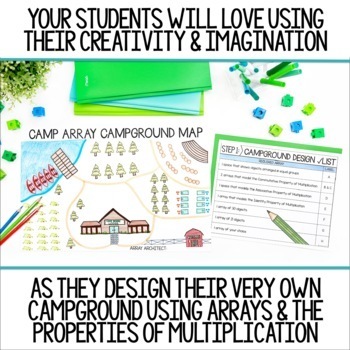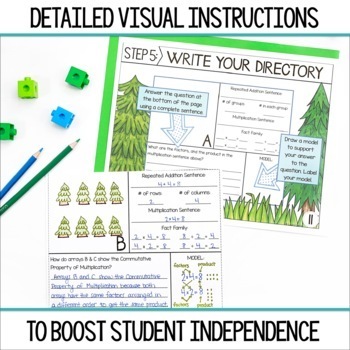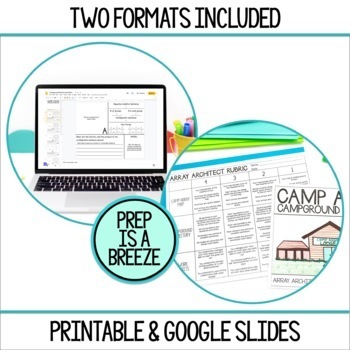Multiplication & Arrays Math Project for 3rd Grade | Design A Campground
- Zip
- Google Apps™

What educators are saying
Description
Camp Array Architect is designed to help your third grade students apply their knowledge about equal groups, arrays, multiplication and division fact families, and properties of multiplication as they design arrays and solve word problems throughout this campground-themed simulation project.
A digital and printable version of this resource are included making it easy to use whether you are teaching in person, using digital distance learning, or a combination of both.
***************************************************************************
WHY TEACHERS LOVE THIS MULTIPLICATION PROJECT
♥ “My students absolutely loved this! I used it with my students who are above grade level instead of doing independent work and they found it to be so interesting! And the directions were so clearly laid out that I did not have to do much explicit teaching!” - April B.
♥ “I always love these projects! I have used this with my whole class when I taught third grade, and as an enrichment activity for some students when I taught second grade. All great things to say every time I use it!” - Mitchell U.
♥ “Such a fun activity to have students apply their knowledge of arrays. We spent a week doing this and students were engaged the whole time.” - Sarah F.
***************************************************************************
PROJECT OVERVIEW
During this math project your third grade students will work toward becoming an Array Architect for Camp Array. As part of their job application process, they must create a campground map that includes a variety of arrays and equal groups, along with a campground directory that features all the equations and problem solving that corresponds with their unique design.
Here are the steps your students will take as they work towards being hired as an Array Architect:
★ Sketch a campground map, which includes arrays and equal groups.
★ Label the arrays and equal groups on their map.
★ Identify the multiplication sentence, repeated addition sentence, and fact family related to each array on their map.
★ Analyze each array on their map, and its relation to the various multiplication properties (Associative, Commutative, Distributive, and Identity Property).
★ Complete a self-assessment of their project using a three-part rubric.
★ Assemble their project according to very specific visual instructions.
***************************************************************************
WHAT’S INCLUDED
★ Teacher Guide - A 7-page guide that includes detailed steps for successfully incorporating this resource in your classroom. This guide includes tips on:
1. Implementing this project in a variety of ways
2. Prepping your project materials efficiently
3. Setting a deadline
4. Introducing the project through a mini lesson
5. Wrapping up the project in a meaningful way
6. Using this project with Google Classroom
7. Aligning this project to third grade math standards
★ Student Guide - a printable and digital version of the student guide is included. This 19-page guide includes detailed instructions and visuals to help your students complete each step of this simulation successfully. The format of this guide makes differentiation easy. Use it as a supplement to your verbal instructions as you provide scaffolding or let your more advanced students work through each step of the project independently.
★ Array Map Template - formatted to be printed on 11” x 17” paper. This template features a light grey grid so students can arrange their arrays with precision.
★ Campground Directory Template - Reproducible pages or Google Classroom-ready digital slides that guide students through the process of writing the repeated addition sentence, multiplication sentence, the fact family related to the arrays drawn on their map, and answering word problems that help them analyze their arrays and use each array to demonstrate their knowledge of the properties of multiplication.
★ Editable Rubric - a 4-point rubric students can use to self-assess their ability to neatly design a map featuring arrays and equal groups, apply multiplication skills while writing their campground directory, and demonstrate the habits of a self-directed learner. The same rubric can be used by the teacher to provide a score for student work. An editable version of this rubric is also included.
★ Sample Project - a completed sample of the project to help you provide scaffolding to students as needed. You will see the first two pages of the Campground Guide are filled out completely, while pages for arrays C-H only include sentence starters for the word problems.
★ Completion Certificate - this congratulatory certificate is a little extra something you can share with students when they receive their project feedback if you’re looking to bring the project to a close in a more formal way.
***************************************************************************
PEDAGOGY
This project based learning unit requires the application of students’ knowledge of equal groups, arrays, multiplication and division fact families, and properties of multiplication. Throughout the process of the Camp Array Architect simulation, students will have the opportunity to apply their knowledge through creative design, engage in rigorous problem solving incorporates their math knowledge, and build organization skills as they plan and execute this multi-day project.
Every step of the Camp Array Architect experience is outlined in a project guide that includes clear visuals and step-by-step instructions. Rubrics and reflection prompts will encourage your students to reach their learning goals.
The format of this project gives students the opportunity to exercise the standards for mathematical practice, share their creativity, and display understanding in unique and engaging ways.
The format of this math simulation guide makes it an ideal resource for:
★ Distance learning
★ At your seat & hands on enrichment during math workshop or guided math
★ Math center work
★ Parent volunteer or teacher’s aide enrichment station
★ A focal point for a multiplication room transformation
***************************************************************************
BOOSTING RIGOR
Students who have mastered the ability to interpret and create equal groups and arrays and how they relate to multiplication and division fact families, and the properties of multiplication will have the opportunity to extend their learning and deepen their understanding of multiplication through this math project experience.
This project will help them solidify the multiplication and arrays skills they’ve mastered through real world problem solving rather than being bogged down with worksheets or busy work.
This project also serves as a wonderful alternative assessment that allows you to measure student understanding on a deeper level as a culmination to your multiplication unit.
***************************************************************************
BUILDING STUDENT INDEPENDENCE
This simulation guide is designed with student independence in mind. Detailed instructions and checklists are provided for students so they can participate with maximum independence.
You can guide them as needed and pull small groups that help address the more individualized needs of your students. This allows students to work at their own pace and take ownership of their learning.
On the day of the simulation launch, you will take 15-20 minutes to set the scene and teach students how to navigate their materials. After that, your students will be off on an independent math adventure that lasts multiple sessions.
***************************************************************************
SAVING TIME
Want to incorporate a project into your multiplication unit, but crunched for instructional time?
This resource makes prepping for project based learning a breeze and makes implementation seamless. The detailed visual instructions on each page of the guide make it possible for students to complete their unique project with maximum independence so you have the time you need to teach or reteach essential place value skills to small groups.
Scoring and providing students with feedback is also when using the included rubric. Each of the three project phases: map design, campground directory creation, and word habits has its own rubric so students can participate in the assessment process as they demonstrate learning, and you can provide them with specific feedback about their work.
***************************************************************************
RELATED THIRD GRADE MULTIPLICATION RESOURCES:
★ Math Project Based Learning Bundle
★ Bundle of Multiplication Word Problem Solving Task Cards for 3rd Grade
★ 3rd Grade Multiplication & Division Fact Fluency Toolkit
★ 3rd Grade Multiplication & Division Math Games
***************************************************************************
LET'S CONNECT: ★ The Core Inspiration Blog ★ Instagram ★ Pinterest ★ Facebook ★





